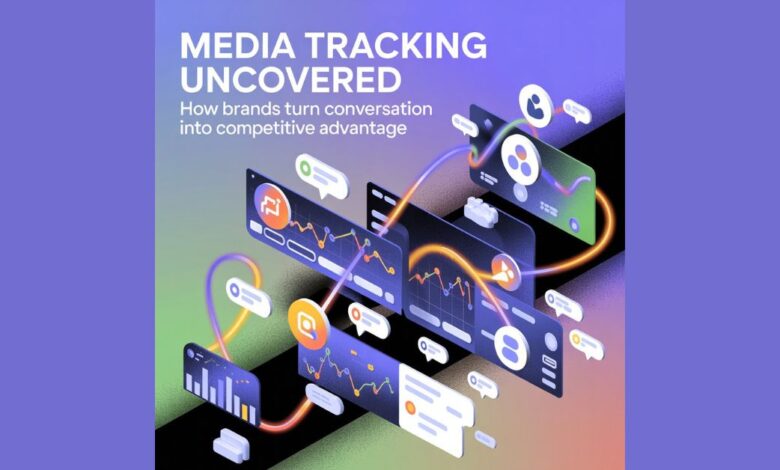Media Tracking Uncovered: How Brands Turn Conversation into Competitive Advantage

In the digital era of hype connection, what others post about your brand does not only affect perception, but it is also the measure of success. A viral conversation can be triggered by one tweet. News headlines can cause a change in investor confidence. The mention of a podcast can influence the perception of the audience towards your product. Media tracking in such a climate has become more of a nice-to-have resource than a strategic need to brands who have decided to remain relevant, informed, and competitive.
Traditional sources and news portals on the Internet, blogs, podcasts, social networks, and live broadcasts, all these platforms are a part of the popular discourse. The brands who invest in full media tracking have the advantage of having a round-the-clock view of how, where, and when they are being talked about. More to the point, they do not simply hear the sound, but they read between the lines and take action before the opportunities or threats become completely apparent.
Media Tracking Matters
Consider the case of a new product that you launch, only to realize that a blog post is distorting your major features. In a few hours, rumors are disseminated in social media, customer forums, and news agencies. Unless you are tracking your media in real time, your brand might not realize the problem until it is already trending. However, with a smart tracking system, you get notifications immediately- you can explain, amend and manage the story before it gets out of control.
The media tracking assists brands in:
- Detect the new trends and discussions before they go viral.
- Gauge sentiment- knowing whether the people are positive, negative or neutral.
- Influencers and journalists that define the presence of your brand.
- Keep track of competitor activities, product releases and changes in the industry that might influence market positioning.
- Early detection of crises will put the communication teams at an advantage in controlling brand reputation.
Simply put, media tracking transforms the hectic, unorganized stream of Internet conversation into orderly, useful intelligence.
The Technology of the New Media Tracking.
Automation, artificial intelligence (AI), and data analytics have provided the impetus to the development of media tracking platforms. The systems of today are much more than mere mention gathering, they read between the lines, the context and intent to show the complete picture.
These tools:
- Real-time aggregation of thousands of digital, print and broadcast sources.
- Apply Natural Language Processing (NLP) to interpret emotional tone, identify sarcasm, and categorize subjects.
- Use machine learning to rank alerts based on possible impact or virality
- Current visual dashboards and sentiment graphs that simplify the complicated data.
This is the combination of AI and analytics that provides not only data but meaning to the brands. Whenever a news item is released about your company or a competitor, the platform brings into focus its reach, influence, and sentiment, enabling decision-makers to make their next steps clearly and swiftly.
The use of Media Tracking by Brands.
Media tracking is not just a mention tracking tool used by modern brands, but it is an essential element in their communication, PR, and strategic intelligence systems.
Here is the way they are putting it into practice:
- Reputation Management: Brand reputation can be maintained through instant negative coverage alerts that enable the brand to respond fast, misinformation management, and maintain trust.
- Campaign Optimization: When launching a new product or promoting a product, real-time tracking can be used to gauge the level of engagement, reach and sentiment, which can show what is working and what is not.
- Influencer Discovery: Companies can also establish a relationship with trusted voices by finding journalists, podcasters or social creators who have already discussed the brand.
- Competitive Benchmarking: Monitoring competitor media presence reveals the opportunities to differentiate and perfect positioning.
Investor and Policy Monitoring: In large organizations, it is beneficial to monitor financial or regulatory debate to ensure that people are talking in line with reality in the market. An interesting case is the use of real-time tracking by consumer electronics brands when launching products. By having early reactions or influencers review the product, the brand can immediately modify the communication, clarify the product features, or emphasize the key differences.
Introduction to Media Tracking.
To businesses that want to develop or enhance their tracking activities, the following is a step-by-step instructions:
- Name important terms: Identify the products, competitors, executives or issues that you would like to track.
- Choose a powerful platform: Select a system that supports various types of media, offers real-time alerts, and has sentiment and trend analysis.
- Create smart alerts: Automate spike in engagement, negative sentiment, or competitor mentions notifications.
- Combine data between teams: Provide shared dashboards to allow marketing, PR, and leadership teams to act together.
- Transform knowledge to action: Transform the media intelligence collected into action by directing campaigns, modifying messages, and increasing customer interactions.
- Refine constantly: Evaluate what alerts or keywords are the most valuable and change tracking parameters.
A media tracking strategy will turn data into direction when executed effectively, and it will enable brands to predict change instead of responding to it.
Final Thoughts
Media tracking offers the visibility, context, and agility that brands require to be ahead in an age characterized by speed and transparency. It enables organizations to know not only what people are saying, but why they are saying it, and how that feeling can be used to affect the market.
With the development of AI-based platforms, tracking will be even more predictive, as it will be able to identify possible trends and threats before they become mainstream. To businesses, this translates to better decision making, better brand protection and competitive advantage.
It is no longer sufficient to listen. Ability to interpret, adapt and act in real time will be the characteristics of successful brands in 2025 and beyond. When you have modern media tracking tools, your organization is able to transform every conversation into a source of growth- and every insight into a strategic advantage.




